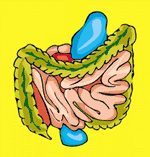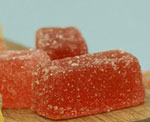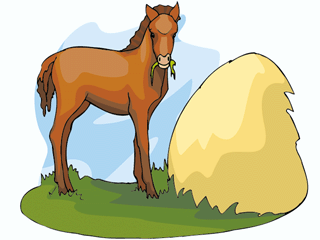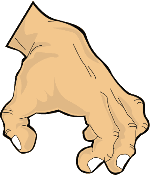Dietary Fiber is a Vital Nutrient
Required to Build your Health and Fight Disease
The amount of dietary fiber in the average North American diet is really very low. This diet is however, very high in fat and processed foods that have been depleted of much of their original fiber and nutrients. As a result, we consume about 80% less of the fiber our ancestors consumed just 100 years ago.
Compare that to the National Cancer Institute's suggested daily fiber intake of between 25 and 35 grams!
In developing countries, 60 grams of total dietary fiber is an average intake per day, and many health specialists recommend 50 grams daily for optimal health. (See table below on food high in fiber.)
Importance of Dietary Fiber
A multitude of scientific studies have been conducted over the last 20 years, which show
the major importance that dietary fiber plays in the prevention and treatment of certain
diseases or conditions.
A low fiber diet has been implicated in appendicitis, cancer of the breast, prostate, colon,
and rectum, elevated cholesterol, gallstones, high blood pressure, coronary heart disease,
diabetes, hemorrhoids, constipation, obesity, etc.
In "Dietary prevention of breast cancer", a paper published in 1990, D.P. Rose and J. M.
Connolly indicated that the approach to breast cancer prevention should include an
increase in fiber consumption to 25 or 30 grams a day.
Apple cider vinegar and apples, like all the fruits, vegetables, and whole grains we eat,
contain soluble and insoluble fiber. (Meat, eggs, and milk products have no fiber)
Soluble fiber such as pectin, gums, and mucilage all dissolve in water. They lower
cholesterol, reduce heart disease risk, improve blood sugar, lower blood pressure, and
they promote the growth of friendly flora.
Insoluble fiber such as cellulose, hemicellulose, and lignin aid digestion, aid elimination,
promote regularity, and contribute to bowel cleaning.
Amount of Dietary Fiber in Food
A normal serving of fruits, vegetables, and whole grains will have anything from about 2
to 9 grams of total fiber. While a processed food like a slice of white bread for example, looses
over 64% of its fiber content, retaining only 0.5 grams dietary fiber.
Since overwhelming evidence links a high level of dietary fiber to health, why not
incorporate not just apple cider vinegar, but more of the following high fiber food into
your daily eating habits and aim for the recommended 50 grams of dietary fiber per day:
| Food | Portion |
Total Fiber (grams) |
| GRAINS | ||
| Bread, seven-grain | 1 slice | 3.2 |
| Bread, whole wheat | 1 slice | 1.4 |
| Bread, pumpernickel | 1 slice | 1.3 |
| Buckwheat | 1 Cup | 9.6 |
| Oatmeal | 1 Cup | 15.4 |
| Rice, brown | 1 cup | 11.0 |
| LEGUMES | ||
| Chickpeas | 1 Cup | 12.0 |
| Green beans | 1 Cup | 4.2 |
| Kidney beans | 1 Cup | 1.6 |
| Lentils | 1 Cup | 6.4 |
| Lima beans | 1 Cup | 8.8 |
| Peas | 1 Cup | 18.2 |
| Pinto beans | 1 Cup | 10.6 |
| Nuts | ||
| almonds | 100 grams | 5.3 |
| chestnuts, w/peel | 1 Cup | 14.5 |
| peanuts | 100 grams | 8.0 |
| walnuts | 100 grams | 5.2 |
| VEGETABLES | ||
| Asparagus | 1 cup | 3.4 |
| Artichoke | 1 Large | 4.5 |
| Beets | 1 Cup | 5,0 |
| broccoli | 1 Cup | 4.0 |
| Carrots | 1 Cup | 4.6 |
| Corn on the cob | 1 Medium | 5.0 |
| Potato | 1 Medium | 3.8 |
| Spinach | 1 Cup | 14.0 |
| Yams | 1 Medium | 6.8 |
| FRUITS | ||
| Apple | 1 Medium | 2.8 |
| Banana | 1 Medium | 2.0 |
| Dates | 2 Medium | 1.2 |
| Figs | 1 Medium | 2.0 |
| Grapefruit | 1 Medium | 1.6 |
| Orange | 1 small | 1.2 |
| Peach | 1 Medium | 2.3 |
| Pear | 1 Medium | 6.0 |
| Prunes | 3 Medium | 1.9 |
| Raspberries | 1 Cup | 9.1 |
An excellent comparative guide, on the amount of fiber in many more popular foods, can be
found in the book New Facts About Fiber![]() by Betty Kamen, Ph.D.
by Betty Kamen, Ph.D.
In this easily readable book, (already in its 6th printing) she presents lots of information on the essential need for fiber and she includes over 300 recent medical references from the literature.
To increase your dietary fiber consumption, she recommends the use of a high-
quality fiber supplement which is composed of more than one type of fiber.






